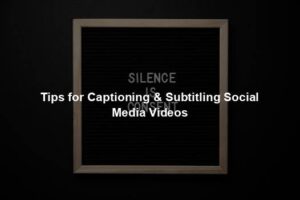
I feel like I have researched and studied film dubbing so widely that I can write this article without the need to refer to any write-up. I have also written a lot of articles on this topic that I can start calling myself a “scholar in film dubbing”. Last time, I wrote about the comparison of dubbing and subtitling and how both processes would fair in different scenarios, we ended up noticing that subtitled films were the most consistent in almost all the scenarios because they are mostly texted while dubbed films wouldn’t be the best option where there was an audio issue, noise or when one did not have ear/headphones to use.
After that, I was compelled to write on some benefits and limitations that are associated with dubbing your films. Dubbing is the layering and synchronizing of a soundtrack of the complete film dialogue which is recorded by voice actors. It is a process that has grown extensively in film production houses while still competing with subtitled films. Both processes are film translation, so it is very common to get people choosing one over the other. Some countries traditionally use subtitles (Scandinavia, the Netherlands and Dutch-speaking Belgium) whereas others prefer dubbing (France, Spain, Germany, and Italy). The choice to use one over the other is highly dependent on a country’s cultural, ideological and linguistic particularities.
In this article, we look at the different benefits and limitations of using or opting for dubbed films.
Benefits of dubbing.
- Hard to identify mistakes. As much as we advocate to look for professional translators, voice actors and video editors there always are potential mistakes that are made that many people end up not noticing that could be noticed by a viewer. The good thing with dubbing, it is very hard for a viewer to notice the mistakes on a dubbed film or even notice that the film has been dubbed. Here, when the original film has content, that is not supported in a particular country or is not in tune with its cultural ideologies it is very easy to censor it and create a new storyline that is in line with the cultural ideologies of that particular place. This would not be possible for a subtitled film because the original audio remains intact with the addition of subtitles at the bottom of the screen. This happened in Spain under Franco’s dictatorship, which prohibited all original versions with subtitles and improved synchronization to change dialogues and convey so‑called higher moral values. It is the best film translation process for content that is inappropriate or that contains low moral standards.
- Dialogues do not need to be abbreviated. Remember how hard it used to be to abbreviate an essay of 400 words? Now imagine having to abbreviate a whole script which might be almost 2000 words depending on how long a film is. With the dubbing process, you don’t have to keep up with abbreviating the text format because it deals with audio from start to finish. The only thing that one has to deal with is to create sentences that are not too long nor too short to fit in writing the timestamps set for the original scenes. Since synchronization is the main factor in the dubbing process, the words must be able to allow coordination of the original actors’ lips.
- Views get to actually watch and enjoy the film. Do you see how you have to keep up with the subtitles when watching subtitled films? That’s not applicable when watching a dubbed film. Watching a dubbed film is like watching the normal original film, more so with the many technological developments surrounding the process. You can watch the movie and enjoy it like you would the original film because of how good the dubbing has been done. Viewers don’t even notice when they are watching a dubbed film, and I feel like that’s exactly how it is supposed to be. I never understand people who enable subtitles when watching a film, I’m of the thought they act more like a distraction to the viewer than anything else. The viewers can focus their attention on the images and the words at the same time, whereas in subtitled versions they constantly have to look up and down the screen to follow the story. So watching a dubbed film is such a vibe and super realistic.
Limitations of Dubbing.
- It has too many steps important in realizing a perfectly dubbed film. Have you ever heard of certain processes that undergo a lot of processes before they can be completed? There are some processes in which one can forego a certain step, and they will still end up being a success. This is not the case for the dubbing process. This process has so many steps, if we are counting they might be close to 7 steps and all the steps have the same level of importance and if one is messed up with, then the final product will have mishaps. From deciding what language you want to dub the film into, to choosing the best translator possible who will make sure that all the translated words are the same as those of the original film, to having someone to create perfect scene time stamps, to getting the best voice over actors and soundproof studios to eventually having the lip-synching done in the best perfect way possible and having the final dubbed film go through a quality check analyst, making sure all these steps are taken care of, is really not easy. To ensure you get a perfectly dubbed film, all this has to be considered.
- Dubbing creates the illusion of an illusion. As much as in the point above I mentioned that all the steps have to be done to perfection to ensure that the dubbed film ends up being as perfect as possible, there are things that cannot be perfect regardless of how much you try. In the dubbing process, it is the synchronizing step. It is hard to have a perfectly synchronized dubbed film. One thing you should note is that dubbing involves Holly different languages which has extremely different pronunciations which case one language might have more word in a statement than the other. This makes it hard for the synchronization to be perfect, even if when the lip movements of the actors are well synchronized with the voice in the translated version. Dubbing only creates an illusion of another illusion. Here, this is something that film production houses have had to deal with for the longest time and will continue to deal with even further because there is no solution for this issue unless someone comes up with a software that will serve as a solution for this problem.
- Expensive. Dubbing is one of the most expensive film processes out there, second to the production of an original film. If you would like to invest in dubbing a film, you should be ready to part with a huge chunk of your money. Therefore, it is very important to create a budget for the dubbing process. It might sound like an easy process, but a lot of things go into doing this. If you are outsourcing the dubbing services, then it would be cheaper than doing everything yourself. You need to look for translators, time coders, voice actors, perfect soundproof studios and video editors and be able to pay for all these according to their set rates whereas an outsourced service provider usually has all these factors taken care of easily and all you have to do is pay a onetime fee. This is exactly why a lot of film companies prefer subtitled films to dubbed films because the expenses to do one dubbed film could go into creating almost 10 subtitled films. Next time you wonder why film producers prefer subtitling films than dubbing, then you know that dubbing is a super expensive and complex process that needs a lot of dedication.
As you have seen from the benefits and limitations I have mentioned above, this is a process that has its fair share of benefits that do not overrule the limitations. I feel like both cancel each other and the only reason to get your film dubbed is if you have the financial capacity to carry it through because all the other benefits are only experienced after the films have been dubbed. If you do not have financial constraints, then dubbing is really the best form of film localization to go with.







